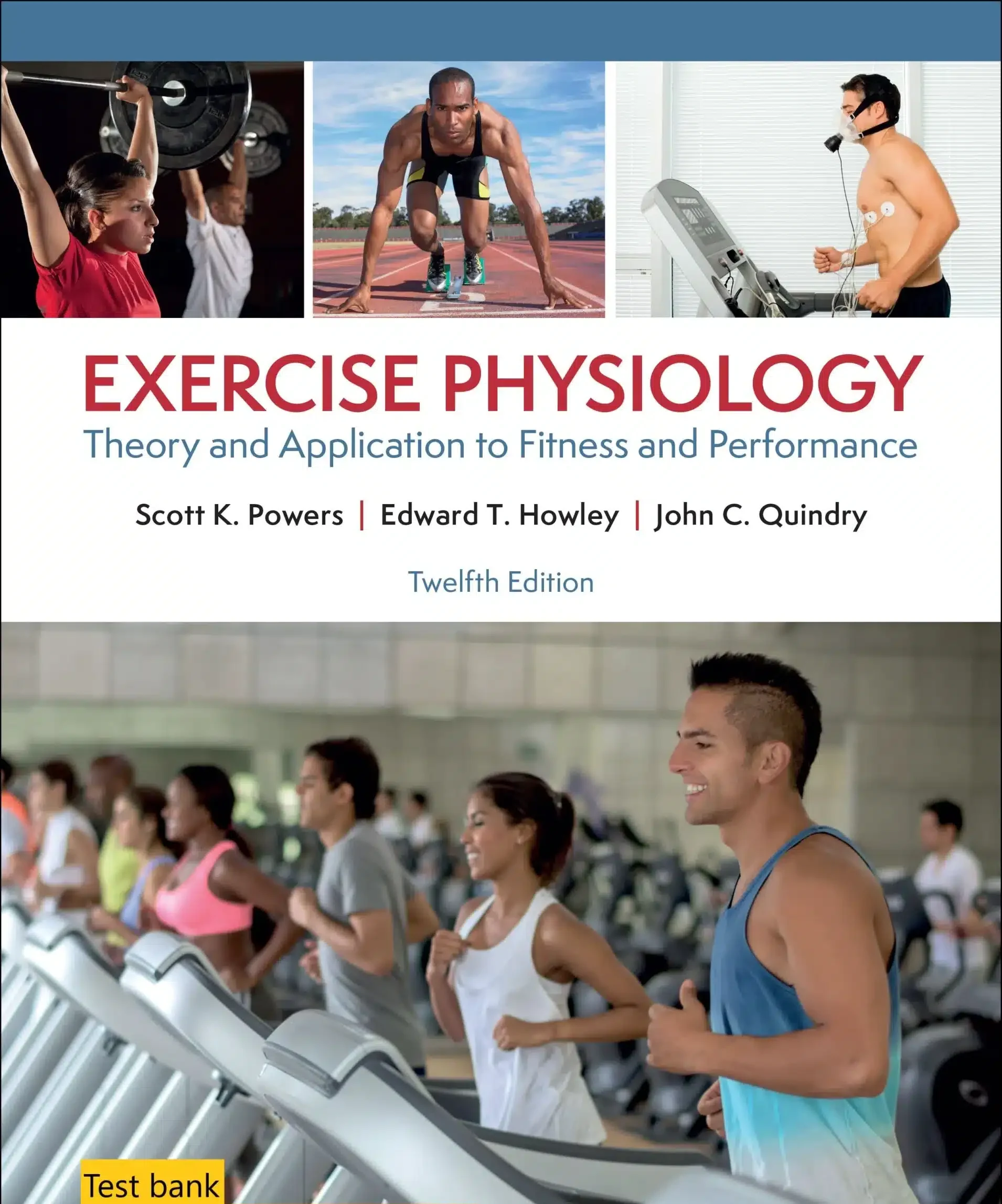Original price was: $39.99.$29.99Current price is: $29.99.
Test bank for Exercise Physiology Theory and Application to Fitness and Performance, 12th Edition By Scott Powers,© 2024
![]()
Product ID: 0909100
For Contact: bookzon.shop@gmail.com
Description
Exercise Physiology: Theory and Application to Fitness and Performance, 12th Edition
By Scott Powers & Dr. John Quindry (©2024)
Test Bank for Exercise Physiology

Overview of the Textbook
Exercise Physiology: Theory and Application to Fitness and Performance, 12th Edition (©2024) is a highly regarded resource designed for students studying various fields such as exercise physiology, clinical exercise physiology, kinesiology, human performance, physical therapy, and physical education. This comprehensive text is ideal for those interested in understanding the physiological processes underlying exercise and how these principles apply to health, fitness, and performance.
The 12th edition provides a detailed exploration of exercise physiology, integrating the latest research findings and numerous clinical applications. It offers instructors the flexibility to tailor the material to suit their specific course needs, making it a versatile textbook for a range of academic programs.
In this edition, the addition of Dr. John Quindry brings fresh perspectives, including three entirely new chapters dedicated to the “Exercise is Medicine” concept, emphasizing the role of exercise in disease prevention and therapy.
Exercise Physiology Theory and Application
Exercise Physiology Theory and Application
Table of Contents(Exercise Physiology Theory and Application to Fitness and Performance, 12th Edition)
Section 1: Physiology of Exercise
-
Chapter 0: Introduction to Physiology of Exercise
An introductory overview of the fundamental principles of exercise physiology, including key concepts and terminology. -
Chapter 1: Common Measurements in Exercise Physiology
A detailed discussion of the various tools and methods used to measure physiological responses during exercise. -
Chapter 2: Control of the Internal Environment
Focuses on how the body maintains homeostasis (internal stability) during exercise and physical exertion. -
Chapter 3: Bioenergetics
Covers the energy systems used during exercise, including ATP production, energy substrates, and their role in fueling physical activity. -
Chapter 4: Exercise Metabolism
Explains the metabolic pathways and biochemical processes that occur during exercise and their implications for performance. -
Chapter 5: Cell Signaling and the Hormonal Responses to Exercise
Describes the cellular signaling mechanisms and the hormonal responses that regulate physiological changes during exercise. -
Chapter 6: Exercise and the Immune System
Discusses the effects of exercise on the immune system, highlighting how exercise influences immune function and response. -
Chapter 7: The Nervous System: Structure and Control of Movement
Provides an overview of the structure and function of the nervous system in regulating movement during exercise. -
Chapter 8: Skeletal Muscle: Structure and Function
Explores the anatomy and physiology of skeletal muscles, focusing on muscle function and adaptation to exercise. -
Chapter 9: Circulatory Responses to Exercise
Investigates the cardiovascular system’s role in supporting exercise, including blood flow, heart rate, and vascular adaptations. -
Chapter 10: Respiration during Exercise
Examines how the respiratory system adjusts to meet increased oxygen demands during physical activity. -
Chapter 11: Acid-Base Balance during Exercise
Focuses on how the body maintains acid-base balance during exercise and how it affects performance. -
Chapter 12: Temperature Regulation
Explains the body’s mechanisms for regulating temperature during exercise to prevent overheating or cooling. -
Chapter 13: The Physiology of Training: Effects of Aerobic and Anaerobic Training
Analyzes the physiological adaptations to different types of training, focusing on aerobic and anaerobic systems. -
Chapter 14: The Physiology of Resistance Training
Discusses the physiological responses and adaptations to resistance training and how it affects strength and muscle mass.
Section 2: Physiology of Health and Fitness
-
Chapter 15: Exercise Is Medicine—Part 1: Prevention of Chronic Diseases
Explores how exercise can prevent chronic diseases, such as cardiovascular diseases, diabetes, and obesity. -
Chapter 16: Exercise is Medicine—Part 2: Therapy for Chronic Diseases and Prevention of Age-related Physiological Dysfunction
Looks at the therapeutic role of exercise in managing chronic diseases and preventing age-related physiological decline. -
Chapter 17: Exercise is Medicine—Part 3: Exercise Prescriptions for Health and Fitness
Provides practical guidelines for prescribing exercise to improve health, fitness, and overall well-being. -
Chapter 18: Nutrition, Body Composition, and Weight Management
Discusses the role of nutrition and body composition in achieving and maintaining healthy body weight.
Section 3: Physiology of Performance
-
Chapter 19: Factors Affecting Performance
Analyzes the various physiological and environmental factors that influence athletic performance. -
Chapter 20: Training for Performance
Offers strategies for improving physical performance through specialized training regimens tailored to different sports and activities. -
Chapter 21: Training for the Female Athlete, Children, Special Populations, and the Masters Athlete
Provides insights into how exercise programs should be adapted for different population groups, including females, children, and older adults. -
Chapter 22: Nutrition, Body Composition, and Performance
Explores the critical relationship between nutrition, body composition, and athletic performance. -
Chapter 23: Exercise and the Environment
Focuses on the impact of environmental factors, such as temperature, altitude, and humidity, on exercise performance. -
Chapter 24: Ergogenic Aids
Investigates the use of ergogenic aids (performance-enhancing substances) and their effects on athletic performance.
Appendices
-
Appendix A: Calculation of Oxygen Uptake and Carbon Dioxide Production
A guide to calculating oxygen consumption and carbon dioxide production during exercise. -
Appendix B: Dietary Reference Intakes: Estimated Energy Requirements
Provides recommended energy intake values based on age, gender, and activity level. -
Appendix C: Dietary Reference Intakes: Vitamins
A comprehensive overview of the vitamins necessary for optimal health and exercise performance. -
Appendix D: Dietary Reference Intakes: Minerals and Elements
Describes the essential minerals and trace elements required for physiological function. -
Appendix E: Percent Fat Estimate for Men: Sum of Triceps, Chest, and Subscapula Skinfolds
A formula for estimating body fat percentage in men based on skinfold measurements. -
Appendix F: Percent Fat Estimate for Women: Sum of Triceps, Abdomen, and Suprailium Skinfolds
A formula for estimating body fat percentage in women based on skinfold measurements. -
Appendix G: MET Equivalents for Exercise, Activities of Daily Living, and Household Chores
Lists the metabolic equivalents (METs) for common activities and household chores to estimate energy expenditure.
For more Test Banks, click here.






Delivers info quickly
Very useful
Strong reference
Professional preparation
Covers the syllabus